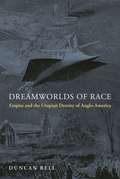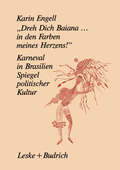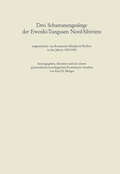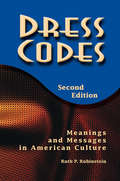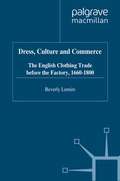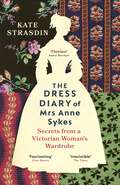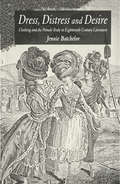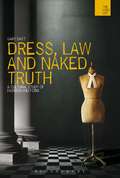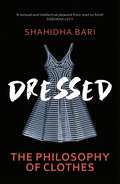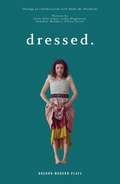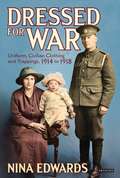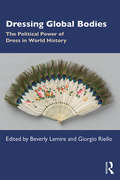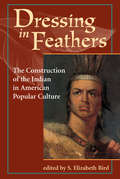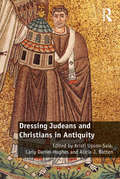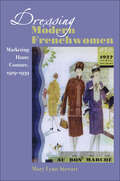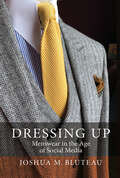- Table View
- List View
Dreamworlds of Race: Empire and the Utopian Destiny of Anglo-America
by Duncan BellHow transatlantic thinkers in the late nineteenth and early twentieth centuries promoted the unification of Britain and the United StatesBetween the late nineteenth century and the First World War an ocean-spanning network of prominent individuals advocated the unification of Britain and the United States. They dreamt of the final consolidation of the Angloworld. Scholars, journalists, politicians, businessmen, and science fiction writers invested the “Anglo-Saxons” with extraordinary power. The most ambitious hailed them as a people destined to bring peace and justice to the earth. More modest visions still imagined them as likely to shape the twentieth century. Dreamworlds of Race explores this remarkable moment in the intellectual history of racial domination, political utopianism, and world order.Focusing on a quartet of extraordinary figures—Andrew Carnegie, W. T. Stead, Cecil J. Rhodes, and H. G. Wells—Duncan Bell shows how unionists on both sides of the Atlantic reimagined citizenship, empire, patriotism, race, war, and peace in their quest to secure global supremacy. Yet even as they dreamt of an Anglo-dominated world, the unionists disagreed over the meaning of race, the legitimacy of imperialism, the nature of political belonging, and the ultimate form and purpose of unification. The racial dreamworld was an object of competing claims and fantasies. Exploring speculative fiction as well as more conventional forms of political writing, Bell reads unionist arguments as expressions of the utopianism circulating through fin-de-siècle Anglo-American culture, and juxtaposes them with pan-Africanist critiques of racial domination and late twentieth-century fictional narratives of Anglo-American empire.Tracing how intellectual elites promoted an ambitious project of political and racial unification between Britain and the United States, Dreamworlds of Race analyzes ideas of empire and world order that reverberate to this day.
Dreamworlds of Race: Empire and the Utopian Destiny of Anglo-America
by Duncan BellHow transatlantic thinkers in the late nineteenth and early twentieth centuries promoted the unification of Britain and the United StatesBetween the late nineteenth century and the First World War an ocean-spanning network of prominent individuals advocated the unification of Britain and the United States. They dreamt of the final consolidation of the Angloworld. Scholars, journalists, politicians, businessmen, and science fiction writers invested the “Anglo-Saxons” with extraordinary power. The most ambitious hailed them as a people destined to bring peace and justice to the earth. More modest visions still imagined them as likely to shape the twentieth century. Dreamworlds of Race explores this remarkable moment in the intellectual history of racial domination, political utopianism, and world order.Focusing on a quartet of extraordinary figures—Andrew Carnegie, W. T. Stead, Cecil J. Rhodes, and H. G. Wells—Duncan Bell shows how unionists on both sides of the Atlantic reimagined citizenship, empire, patriotism, race, war, and peace in their quest to secure global supremacy. Yet even as they dreamt of an Anglo-dominated world, the unionists disagreed over the meaning of race, the legitimacy of imperialism, the nature of political belonging, and the ultimate form and purpose of unification. The racial dreamworld was an object of competing claims and fantasies. Exploring speculative fiction as well as more conventional forms of political writing, Bell reads unionist arguments as expressions of the utopianism circulating through fin-de-siècle Anglo-American culture, and juxtaposes them with pan-Africanist critiques of racial domination and late twentieth-century fictional narratives of Anglo-American empire.Tracing how intellectual elites promoted an ambitious project of political and racial unification between Britain and the United States, Dreamworlds of Race analyzes ideas of empire and world order that reverberate to this day.
„Dreh‘ Dich Baiana... In den Farben meines Herzens!“: Karneval in Brasilien — Ein Spiegel politischer Kultur
by Karin EngellDrei Schamanengesänge der Ewenki-Tungusen Nord-Sibiriens: aufgezeichnet von Konstantin Mixajlovi? Ry?kov in den Jahren 1905/1909 (Abhandlungen der Nordrhein-Westfälischen Akademie der Wissenschaften #89)
by Karl Heinrich MengesDress Codes: Meanings And Messages In American Culture
by Ruth RubinsteinRich with illustrations, this revised and updated second edition of Dress Codes systematically analyzes the meaning and relevance of clothing in American culture. Presented here is an up-to-date analysis of images of power and authority, gender, seduction (the sexy look, the alluring look, the glamorous look, the vulnerable look), wealth and beauty, youth and health, and leisure and political hierarchy. Taken together, the chapters offer to the student and the general reader a complete "semiotics of clothing" in a form that is highly readable, very entertaining, and thoroughly informative. The illustrations provide fascinating glimpses into the history of American fashion and clothing-along with their antecedents in Europe-as well as a fine collection of images from the more familiar world of contemporary America.Rubinstein has identified six distinct categories of dress in American society, upon which Dress Codes is based. "Clothing signs" were instituted by those in authority, have one meaning, indicate behavior, and are required attire (police uniforms, or the clothing of ministers and priests); ?clothing symbols," on the other hand, reflect the achievement of cultural values?wealth, beauty, you and health. The wearing of clothing symbols?designer clothing or jewelry?may have several meanings; '`'clothing tie-signs,? which are specific types of clothing that indicate membership in a community outside mainstream culture (Hasidic, Amish, or Hare Krishna attire). They were instituted by those in authority, have one meaning, they indicate expected behavior, and are required attire; ?clothing tie symbols? emanate from hopes, fears, and dreams of particular groups. They include trendy styles such as hip-hop, hippie, and gothic. Another category, ?contemporary fashion,? reflects consumer sentiments and the political and economic forces of the period. ?Personal dress,? refers to the "I" component we bring in when dressing the public self (bowtie, dramatic, or artistic attire). Many of these images have their roots in the ?collective memory? of western society. Written in a lively and entertaining style,Dress Codes will fascinate both general readers and students interested in the history of fashion and costume, fashion design, human development, and gender studies.
Dress Codes: Meanings And Messages In American Culture
by Ruth RubinsteinRich with illustrations, this revised and updated second edition of Dress Codes systematically analyzes the meaning and relevance of clothing in American culture. Presented here is an up-to-date analysis of images of power and authority, gender, seduction (the sexy look, the alluring look, the glamorous look, the vulnerable look), wealth and beauty, youth and health, and leisure and political hierarchy. Taken together, the chapters offer to the student and the general reader a complete "semiotics of clothing" in a form that is highly readable, very entertaining, and thoroughly informative. The illustrations provide fascinating glimpses into the history of American fashion and clothing-along with their antecedents in Europe-as well as a fine collection of images from the more familiar world of contemporary America.Rubinstein has identified six distinct categories of dress in American society, upon which Dress Codes is based. "Clothing signs" were instituted by those in authority, have one meaning, indicate behavior, and are required attire (police uniforms, or the clothing of ministers and priests); ?clothing symbols," on the other hand, reflect the achievement of cultural values?wealth, beauty, you and health. The wearing of clothing symbols?designer clothing or jewelry?may have several meanings; '`'clothing tie-signs,? which are specific types of clothing that indicate membership in a community outside mainstream culture (Hasidic, Amish, or Hare Krishna attire). They were instituted by those in authority, have one meaning, they indicate expected behavior, and are required attire; clothing tie symbols emanate from hopes, fears, and dreams of particular groups. They include trendy styles such as hip-hop, hippie, and gothic. Another category, contemporary fashion, reflects consumer sentiments and the political and economic forces of the period. Personal dress, refers to the "I" component we bring in when dressing the public self (bowtie, dramatic, or artistic attire). Many of these images have their roots in the collective memory of western society. Written in a lively and entertaining style, Dress Codes will fascinate both general readers and students interested in the history of fashion and costume, fashion design, human development, and gender studies.
Dress, Culture and Commerce: The English Clothing Trade before the Factory, 1660–1800
by B. LemireThis work examines a trade that covered the backs of sailors and soldiers, that shirted labouring men and skirted working women, that employed legions of needlewomen and supplied retailers with new consumer wares. Garments, once bought, returned again to the marketplace, circulating like a currency and bolstering demand. The agents in this trade included military contractors for clothing, female outworkers and dealers in used clothes. Each was affected by a changing demand for new-styled 'luxuries' and necessities in apparel.
The Dress Diary of Mrs Anne Sykes: Secrets from a Victorian Woman’s Wardrobe
by Kate StrasdinThe hidden fabric of a Victorian woman's life told through her unique scrapbook.In 1838, Anne Sykes was given a diary on her wedding day. Using it to collect snippets of fabric, she created a record of her life and times. Nearly two hundred years later, the diary fell into the hands of fashion historian Kate Strasdin who spent the next six years unravelling the secrets contained within its pages.Piece by piece, she charts Anne's life and times. Fragments of cloth become windows into Victorian life: pirates in Borneo, the complicated etiquette of mourning, poisonous dyes, the British Empire in full swing, rioting over working conditions and the terrible human cost of Britain's cotton industry. Through the evidence of waistcoats, ball gowns and mourning outfits, Strasdin lays bare the whole of human experience in the most intimate of mediums: the clothes we choose to wear.‘Flawless’ Amber Butchart‘Fascinating’ Clare Hunter‘Irresistible’ The Times
Dress, Distress and Desire: Clothing and the Female Body in Eighteenth-Century Literature
by J. BatchelorDress, Distress and Desire explores representations of sartorial experience in eighteenth-century literature. Batchelor's study brings together for the first time canonical and non-canonical texts including novels, conduct books and women's magazines to investigate the pressures that the growth of the fashion market placed on conceptions of female virtue and propriety. It shows how dress dispelled the sentimental myth that the body acted as a moral index and enabled the women reader to resist some of sentimental literature's more prescriptive advice.
Dress, Law and Naked Truth: A Cultural Study of Fashion and Form (The WISH List)
by Gary WattWhy are civil authorities in so-called liberal democracies affronted by public nudity and the Islamic full-face 'veil'? Why is law and civil order so closely associated with robes, gowns, suits, wigs and uniforms? Why is law so concerned with the 'evident' and the need for justice to be 'seen' to be done? Why do we dress and obey dress codes at all? In this, the first ever study devoted to the many deep cultural connections between dress and law, the author addresses these questions and more. His responses flow from the radical thesis that 'law is dress and dress is law'.Engaging with sources from The Epic of Gilgamesh to Shakespeare, Carlyle, Dickens and Damien Hirst, Professor Watt draws a revealing history of dress and civil order and offers challenging conclusions about the nature of truth and the potential for individuals to fit within the forms of civil life.
Dressed: The Secret Life of Clothes
by Dr Shahidha BariWe are all dressed. But how often do we pause to think about the place of our clothes in our lives? What unconscious thoughts do we express when we dress every day? Can memories, meaning and ideas be wrapped up in a winter coat?These are the questions that interest Shahidha Bari, as she explores the secret language of our clothes. Ranging freely through literature, art, film and philosophy, Dressed tracks the hidden power of clothes in our culture and our daily lives. From the depredations of violence and ageing to our longing for freedom, love and privacy, from the objectification of women to the crisis of masculinity, each garment exposes a fresh dilemma. Item by item, the story of ourselves unravels. Evocative, enlightening and dazzlingly original, Dressed is not just about clothes as objects of fashion or as a means of self-expression. This is a book about the deepest philosophical questions of who we are, how we see ourselves and how we dress to face the world.
dressed. (Oberon Modern Plays)
by ThisEggAfter being stripped at gunpoint, Lydia set out to redress herself with a new healing set of armour. Lydia now only wears clothes she has made. Told with a tender intimacy, dressed. is a true story told by four women who have been friends since school. Combining choreography, live sewing, comedy and original music, dressed. celebrates the power clothes have to define us, to liberate us, to hide us and to embellish us.
Dressed for War: Uniform, Civilian Clothing and Trappings, 1914 to 1918
by Nina EdwardsMen in khaki and grey squatting in the trenches, women at work, gender bending in goggles, with overalls on over their trousers. What people wear matters. Well illustrated, this book tells the stories of what people on both sides wore on the front line and on the home front through the seismic years of World War I. Nina Edwards reveals fresh aspects of the war through the prism of the smallest details of personal dress, of clothes, hair and accessories, both in uniform and civilian wear. She explores how, during a period of extraordinary upheaval and rapid change, wearing a certain perfume, say, or the just-so adjustment to the tilt of a hat offer insights into the individual experience of men, women and children during the course of World War I.
Dressing Global Bodies: The Political Power of Dress in World History
by Beverly Lemire Giorgio RielloDressing Global Bodies addresses the complex politics of dress and fashion from a global perspective spanning four centuries, tying the early global to more contemporary times, to reveal clothing practice as a key cultural phenomenon and mechanism of defining one’s identity. This collection of essays explores how garments reflect the hierarchies of value, collective and personal inclinations, religious norms and conversions. Apparel is now recognized for its seminal role in global, colonial and post-colonial engagements and for its role in personal and collective expression. Patterns of exchange and commerce are discussed by contributing authors to analyse powerful and diverse colonial and postcolonial practices. This volume rejects assumptions surrounding a purportedly all-powerful Western metropolitan fashion system and instead aims to emphasize how diverse populations seized agency through the fashioning of dress. Dressing Global Bodies contributes to a growing scholarship considering gender and race, place and politics through the close critical analysis of dress and fashion; it is an indispensable volume for students of history and especially those interested in fashion, textiles, material culture and the body across a wide time frame.
Dressing Global Bodies: The Political Power of Dress in World History
by Beverly Lemire Giorgio RielloDressing Global Bodies addresses the complex politics of dress and fashion from a global perspective spanning four centuries, tying the early global to more contemporary times, to reveal clothing practice as a key cultural phenomenon and mechanism of defining one’s identity. This collection of essays explores how garments reflect the hierarchies of value, collective and personal inclinations, religious norms and conversions. Apparel is now recognized for its seminal role in global, colonial and post-colonial engagements and for its role in personal and collective expression. Patterns of exchange and commerce are discussed by contributing authors to analyse powerful and diverse colonial and postcolonial practices. This volume rejects assumptions surrounding a purportedly all-powerful Western metropolitan fashion system and instead aims to emphasize how diverse populations seized agency through the fashioning of dress. Dressing Global Bodies contributes to a growing scholarship considering gender and race, place and politics through the close critical analysis of dress and fashion; it is an indispensable volume for students of history and especially those interested in fashion, textiles, material culture and the body across a wide time frame.
Dressing In Feathers: The Construction Of The Indian In American Popular Culture
by S. Elizabeth BirdOne hundred members of NatChat, an electronic mail discussion group concerned with Native American issues, responded to the recent Disney release Pocahontas by calling on parents to boycott the movie, citing its historical inaccuracies and saying that ?Disney has let us down in a cruel, irresponsible manner.? Their anger was rooted in the fact that, although Disney claimed that the film's portrayal of American Indians would be ?authentic,? the Pocahontas story their movie told was really white cultural myth. The actual histories of the characters were replaced by mythic narratives depicting the crucial moments when aid was given to the white settlers. As reconstructed, the story serves to reassert for whites their right to be here, easing any lingering guilt about the displacement of the native inhabitants.To understand current imagery, it is essential to understand the history of its making, and these essays mesh to create a powerful, interconnected account of image creation over the past 150 years. The contributors, who represent a range of disciplines and specialties, reveal the distortions and fabrications white culture has imposed on significant historical and current events, as represented by treasured artifacts, such as photographic images taken of Sitting Bull following his surrender, the national monument at the battlefield of Little Bighorn, nineteenth-century advertising, the television phenomenon Northern Exposure, and the film Dances with Wolves.Well illustrated, this volume demonstrates the complacency of white culture in its representation of its troubled relationship with American Indians.
Dressing In Feathers: The Construction Of The Indian In American Popular Culture
by S. Elizabeth BirdOne hundred members of NatChat, an electronic mail discussion group concerned with Native American issues, responded to the recent Disney release Pocahontas by calling on parents to boycott the movie, citing its historical inaccuracies and saying that "Disney has let us down in a cruel, irresponsible manner." Their anger was rooted in the fact that, although Disney had claimed that the film's portrayal of American Indians would be "authentic," the Pocahontas story the movie told was really white cultural myth. The actual histories of the characters were replaced by mythic narratives depicting the crucial moments when aid was given to the white settlers. As reconstructed, the story serves to reassert for whites their right to be here, easing any lingering guilt about the displacement of the native inhabitants. To understand current imagery, it is essential to understand the history of its making, and these essays mesh to create a powerful, interconnected account of image creation over the past 150 years. The contributors, who represent a range of disciplines and specialties, reveal the distortions and fabrications white culture has imposed on significant historical and current events, as represented by treasured artifacts such as photographic images taken of Sitting Bull following his surrender, the national monument at the battlefield of Little Bighorn, nineteenth-century advertising, the television phenomenon Northern Exposure, and the film Dances with Wolves. Well illustrated, this volume demonstrates the complacency of white culture in its representation of its troubled relationship with American Indians.
Dressing Judeans and Christians in Antiquity
by Kristi Upson-Saia Carly Daniel-Hughes Alicia J. BattenThe past two decades have witnessed a proliferation of scholarship on dress in the ancient world. These recent studies have established the extent to which Greece and Rome were vestimentary cultures, and they have demonstrated the critical role dress played in communicating individuals’ identities, status, and authority. Despite this emerging interest in ancient dress, little work has been done to understand religious aspects and uses of dress. This volume aims to fill this gap by examining a diverse range of religious sources, including literature, art, performance, coinage, economic markets, and memories. Employing theoretical frames from a range of disciplines, contributors to the volume demonstrate how dress developed as a topos within Judean and Christian rhetoric, symbolism, and performance from the first century BCE to the fifth century CE. Specifically, they demonstrate how religious meanings were entangled with other social logics, revealing the many layers of meaning attached to ancient dress, as well as the extent to which dress was implicated in numerous domains of ancient religious life.
Dressing Judeans and Christians in Antiquity
by Kristi Upson-Saia Carly Daniel-Hughes Alicia J. BattenThe past two decades have witnessed a proliferation of scholarship on dress in the ancient world. These recent studies have established the extent to which Greece and Rome were vestimentary cultures, and they have demonstrated the critical role dress played in communicating individuals’ identities, status, and authority. Despite this emerging interest in ancient dress, little work has been done to understand religious aspects and uses of dress. This volume aims to fill this gap by examining a diverse range of religious sources, including literature, art, performance, coinage, economic markets, and memories. Employing theoretical frames from a range of disciplines, contributors to the volume demonstrate how dress developed as a topos within Judean and Christian rhetoric, symbolism, and performance from the first century BCE to the fifth century CE. Specifically, they demonstrate how religious meanings were entangled with other social logics, revealing the many layers of meaning attached to ancient dress, as well as the extent to which dress was implicated in numerous domains of ancient religious life.
Dressing Modern Frenchwomen: Marketing Haute Couture, 1919–1939
by Mary Lynn StewartAt a glance, high fashion and feminism seem unlikely partners. Between the First and Second World Wars, however, these forces combined femininity and modernity to create the new, modern French woman. In this engaging study, Mary Lynn Stewart reveals the fashion industry as an integral part of women's transition into modernity. Analyzing what female columnists in fashion magazines and popular women novelists wrote about the "new silhouette," Stewart shows how bourgeois women feminized the more severe, masculine images that elite designers promoted to create a hybrid form of modern that both emancipated women and celebrated their femininity. She delves into the intricacies of marketing the new clothes and the new image to middle-class women and examines the nuts and bolts of a changing industry—including textile production, relationships between suppliers and department stores, and privacy and intellectual property issues surrounding ready-to-wear couture designs. Dressing Modern Frenchwomen draws from thousands of magazine covers, advertisements, fashion columns, and features to uncover and untangle the fascinating relationships among the fashion industry, the development of modern marketing techniques, and the evolution of the modern woman as active, mobile, and liberated.
Dressing Modern Frenchwomen: Marketing Haute Couture, 1919–1939
by Mary Lynn StewartAt a glance, high fashion and feminism seem unlikely partners. Between the First and Second World Wars, however, these forces combined femininity and modernity to create the new, modern French woman. In this engaging study, Mary Lynn Stewart reveals the fashion industry as an integral part of women's transition into modernity. Analyzing what female columnists in fashion magazines and popular women novelists wrote about the "new silhouette," Stewart shows how bourgeois women feminized the more severe, masculine images that elite designers promoted to create a hybrid form of modern that both emancipated women and celebrated their femininity. She delves into the intricacies of marketing the new clothes and the new image to middle-class women and examines the nuts and bolts of a changing industry—including textile production, relationships between suppliers and department stores, and privacy and intellectual property issues surrounding ready-to-wear couture designs. Dressing Modern Frenchwomen draws from thousands of magazine covers, advertisements, fashion columns, and features to uncover and untangle the fascinating relationships among the fashion industry, the development of modern marketing techniques, and the evolution of the modern woman as active, mobile, and liberated.
Dressing Up: Menswear in the Age of Social Media
by Joshua M. BluteauWhat does men’s fashion say about contemporary masculinity? How do these notions operate in an increasingly digitized world? To answer these questions, author Joshua M. Bluteau combines theoretical analysis with vibrant narrative, exploring men’s fashion in the online world of social media as well as the offline worlds of retail, production, and the catwalk. Is it time to reassess notions of masculinity? How do we construct ourselves in the online world, and what are the dangers of doing so? From the ateliers of London to the digital landscape of Instagram, Dressing Up re-examines the ways men dress, and the ways men post.
Dressing Up: Menswear in the Age of Social Media
by Joshua M. BluteauWhat does men’s fashion say about contemporary masculinity? How do these notions operate in an increasingly digitized world? To answer these questions, author Joshua M. Bluteau combines theoretical analysis with vibrant narrative, exploring men’s fashion in the online world of social media as well as the offline worlds of retail, production, and the catwalk. Is it time to reassess notions of masculinity? How do we construct ourselves in the online world, and what are the dangers of doing so? From the ateliers of London to the digital landscape of Instagram, Dressing Up re-examines the ways men dress, and the ways men post.
Dressing Up: Menswear in the Age of Social Media
by Joshua M. BluteauWhat does men’s fashion say about contemporary masculinity? How do these notions operate in an increasingly digitized world? To answer these questions, author Joshua M. Bluteau combines theoretical analysis with vibrant narrative, exploring men’s fashion in the online world of social media as well as the offline worlds of retail, production, and the catwalk. Is it time to reassess notions of masculinity? How do we construct ourselves in the online world, and what are the dangers of doing so? From the ateliers of London to the digital landscape of Instagram, Dressing Up re-examines the ways men dress, and the ways men post.
Dressing Up: Menswear in the Age of Social Media
by Joshua M. BluteauWhat does men’s fashion say about contemporary masculinity? How do these notions operate in an increasingly digitized world? To answer these questions, author Joshua M. Bluteau combines theoretical analysis with vibrant narrative, exploring men’s fashion in the online world of social media as well as the offline worlds of retail, production, and the catwalk. Is it time to reassess notions of masculinity? How do we construct ourselves in the online world, and what are the dangers of doing so? From the ateliers of London to the digital landscape of Instagram, Dressing Up re-examines the ways men dress, and the ways men post.
